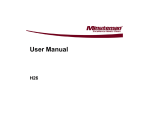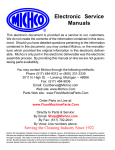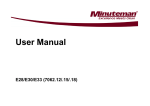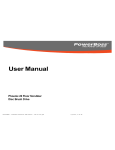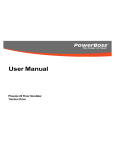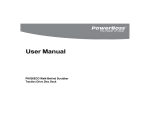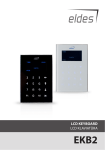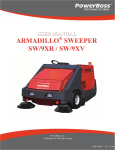Download 988026umpb - User Manual - Phoenix 26 Floor
Transcript
PowerBoss® The Power of Clean User Manual Operation & Safety Phoenix 26 PowerBoss,Inc. A member Of The Hako Group 1 Introduction Preface Dear customer, It is our desire that the good characteristics of the Phoenix 26 should justify the confidence you demonstrated by making this purchase. Prior to the first operation, carefully read the chapter “Safety Information” in order to ensure your safety working with the machine. Your own safety, as well as the safety of others, depends greatly on how the vehicle is moved and operated. Therefore, carefully read and understand this manual before operation. This manual provides valuable information about operation, service and maintenance. The warning symbols used in this manual identifies items that are relevant to safety. Please observe the safety provisions (see chapter “Safety Information”). Your authorized PowerBoss dealer will be pleased to answer further questions regarding the unit or the operation and maintenance manual. Please be advised explicitly that we cannot accept any legal issues out of the contents of this manual. If repair work must be performed make sure that only genuine spare parts are used. Genuine spare parts help guarantee a dependable machine. We reserve the right to make changes without notice. 2 Valid as of: November 2011 PowerBoss,Inc. 175 Anderson Street Aberdeen, North Carolina 28315 Proper use The Phoenix 26 machine is a vacuum scrubbing machine used for the wet cleaning of hard-surfaced floors. Using the machine beyond this scope of it’s application will be deemed improper and negligent use. The manufacturer cannot be held liable for consequential damages, the user alone bears the risk. The term of proper use also includes operation, maintenance and repair work to be performed in compliance with the manufacturer’s specifications. The Phoenix 26 may be used by Qualified persons familiar with the machine and aware of possible hazards involved. The applicable Accident Prevention Regulations and further regulations concerning safety and work must be complied with. Introduction Acceptance of the machine If modifications to the machine are made in absence of the manufacturer’s prior consent, PowerBoss cannot be held liable for damage resulting from such unauthorized modification. Notes on warranty The terms of the sales contract apply. Damages are not subject to warranty if they are due to non-compliance with the maintenance and service provisions. The maintenance work has to be performed by an authorized PowerBoss service center and confirmed in the “Maintenance Certificate” which is the warranty document. The following is excluded from warranty: fuses, natural wear items such as squeegee blades, skirts and brushes. Damages caused by overload, negligence and unauthorized modification of the machine are not covered by warranty. Moreover, any claim for warranty cannot be accepted if damages of the machine are caused by improper fitting of parts or accessories without PowerBoss’s prior consent, or by non-compliance with the maintenance instructions and schedule. Upon arrival, check machine for possible damages in transit. Follow unpacking instructions on shipping pallet. Each unit has been tested and thoroughly inspected before shipment. Any damage is the responsibility of the delivery carrier who should be notified immediately. For refund of such damage, have the freight forwarder confirm damage and mail notification along with waybill to: PowerBoss,Inc. 175 Anderson Street Aberdeen, North Carolina 28315 3 Table Of Contents 1 Safety information .......................................................................5 1.1 Safety and Warning Symbols ........................................................... 5 1.2 General Provisions ............................................................................ 6 1.3 Provisions for Operation .................................................................. 6 1.4 Maintenance instructions ................................................................. 7 1.5 Specific Hazards ................................................................................ 7 1.5.1 Electric system ........................................................................... 7 1.5.2 Battery ......................................................................................... 7 1.6 Information for Protection of Environment ..................................... 8 1.7 Labels On The Machine .................................................................... 9 2 First Operation ...........................................................................10 2.1 Instruction ........................................................................................ 10 2.2 Initial Charging Procedure ............................................................. 10 2.3 Before Operation Of Machine ......................................................... 10 2.4 Start Machine ................................................................................... 10 2.5 Operation ......................................................................................... 11 2.6 Stopping The Machine .................................................................... 11 2.7 After Work ........................................................................................ 11 2.8 Transport Mode ............................................................................... 11 2.9 Tie Down Points............................................................................... 11 3 Operation....................................................................................12 3.1 Method Of Operation ....................................................................... 12 3.1.1 Scrub Head Assembly.............................................................. 12 3.1.2 Clean Water Tank...................................................................... 12 3.1.3 Squeegee .................................................................................. 13 3.1.4 Dirty Water Recovery Tank ...................................................... 13 3.1.5 Drive System............................................................................. 13 3.1.6 Batteries and Charger .............................................................. 13 3.1.7 Options ...................................................................................... 13 3.2 Control Panel & Operation Indicators ........................................... 14 3.2.1 Operating Panel ........................................................................ 14 3.2.2 At The Machine ......................................................................... 17 4 Technical Data ...........................................................................20 5 Maintenance and Care ..............................................................22 5.1 General ............................................................................................. 22 5.2 Maintenance Document .................................................................. 23 4 5.3 Maintenance Schedule .................................................................... 24 PowerBoss System Maintenance Customer .................................. 24 PowerBoss System Maintenance I .................................................. 25 PowerBoss System Maintenance II ................................................. 26 PowerBoss System Maintenance S (Safety check) ....................... 27 5.4 Battery Systems .............................................................................. 28 5.4.1 Charging The Batteries ............................................................ 29 5.4.2 Low Discharge Signal Sender (LDS) ...................................... 29 5.4.3 Maintenance of Batteries ......................................................... 29 5.4.4 Removing Batteries.................................................................. 29 5.4.5 Installing Batteries ................................................................... 29 5.4.6 Disposal of Batteries................................................................ 29 5.5 Clean Water Solution Tank ............................................................. 30 5.5.1 Filling Clean Water Solution Tank........................................... 31 5.5.2 Empty Clean Water Solution Tank .......................................... 31 5.5.3 Cleaning Clear Water Filter..................................................... 31 5.6.1 Empty Dirty Water Recovery Tank .......................................... 33 5.6.2 Cleaning Dirty Water Recovery Tank ...................................... 33 5.6.3 Clean Suction Filter.................................................................. 33 5.7 Disc Type Scrub Head .................................................................... 34 5.7.1 Cleaning Brushes ..................................................................... 34 5.7.2 Changing Brushes ................................................................... 34 5.7.3 Changing Deflector Roller ....................................................... 34 5.7.4 Changing Scrub Head Skirt .................................................... 34 5.8 Squeegee ........................................................................................ 35 5.8.1 Cleaning the Squeegee ............................................................ 35 5.8.2 Changing the Squeegee Blades.............................................. 35 5.8.3 Adjusting the Sealing Strips.................................................... 36 5.9 Cylindrical Scrub Head .................................................................. 38 5.9.1 Cleaning Debris Hopper .......................................................... 38 5.9.2 Removing Brushes................................................................... 38 5.10 Squeegee ....................................................................................... 39 5.10.1 Cleaning Squeegee Assembly .............................................. 39 5.10.2 Changing Squeegee Blades .................................................. 39 5.10.3 Adjusting Squeegee Assembly ............................................. 39 6. Warranty Information ...............................................................40 Safety Information 1 Safety information 1.1 Safety and Warning Symbols All paragraphs in this manual referring to your personal safety, the safety of your machine and the environment protection are recognized by one of the following warning symbols: Symbol Warning Hazardous for ... Persons and Goods Note Ecological Hazard NOTICE Description Indicates a hazardous situation which could result in death or serious injury. Indicates important or additional information. The Environment All Indicates the use of substances representing an inherent danger to the health of the environment. Indicates a potentially hazardous situation which may result in equipment or property damange. 5 Safety Information 1.2 General Provisions • Apart from the provisions contained in this instruction manual, the general safety provisions and the accident prevention regulations as imposed by law must be complied with. • Before operating your machine, carefully read the instruction manual as well as other separate instructions for accessories or attached implements. Comply with all points mentioned there during work. • Only persons trained by qualified PowerBoss personnel are authorized to operate, service and repair the machine. • You are advised to thoroughly study the safety instructions, this will help in avoiding errors during operation of the machine and thus guarantees correct usage of the machine. • The operating instructions must be at on hand at the place of machine use, and therefore have to be kept readily available at the machine. • When selling or lending the machine for rent, hand out these documents to the new owner/operator and have the transfer certified! • The warning and instruction plates attached to the machine contain valuable advice about safe operation. Immediately replace incomplete or illegible labels. • For safety standards spare parts must be equal to genuine parts! 1.3 Provisions for Operation • Before the first operation of the machine, fully charge the battery with an initial charging procedure and comply with the operating instructions of the charger as well as with those of the battery manufacturer. PowerBoss cannot be held liable for damages resulting from the fact that the initial charging has not or insufficiently done. • Before operation, check the machine for operational safety! Immediately remedy malfunctions! • It is necessary for the operator to get acquainted with all attachments and controls as well as with their function before operation begins. • When operating the machine use of firm and skid proof shoes is recommended. • The machine may be used only on such surfaces clearly specified by the owner or his authorized representative. • When operating the machine take notice of persons within the operation area especially children. • Start moving immediately after brush head has lowered otherwise the brush might leave traces on the surface. Lift the brush head before going over obstacles (doorsteps). • Empty dirty water tank before folding recovery tank over. • Use only cleaning agents suitable for automatic machines (low-foaming) and comply with the instructions for use, disposal and with the warning information specified by the cleaning agent’s manufacturer. • The machine is not designed for collecting hazardous, inflammable or explosive dust or substances. • Usage of the machine in explosive areas is prohibited. • Pull the ignition key to avoid unauthorized use of the machine. 6 Safety Information • Before transporting the machine, lift the squeegee and the scrub head assemblies. Adapt operation of machine to the local conditions. • The machine may be used only for operation on plane areas with a maximum inclination of 2 %. 1.4 Maintenance instructions • The daily and weekly maintenance and repair task must be performed by a qualified operator. For any maintenance and repair work beyond this please contact your local PowerBoss service center. • Observe the maintenance activities and intervals set out in the instruction manual. • Maintenance and repair work should be carried out with use of the appropriate tools. • Have the machine checked for safety conditions in the sense of the Accident Prevention Regulation by an expert at regular intervals recommendation: (at least once yearly) as well as after modifications or repairs. • Spare parts must be equal to the technical requirements as specified by the manufacturer. Using genuine spare parts guarantee compliance with these requirements. • Stop engine before proceeding to inspection and maintenance work. • To prevent the machine from being used by unauthorized persons, the ignition key should be removed. • When performing work on the electrical system, be sure to disconnect the battery plug. • Make sure to protect the dirty water tank against accidental closing or tilting down before working in the area of a lifted tank lid. • Do not clean the electrical parts by means of high-pressure cleaning equipment. • The use of aggressive detergents is not recommended. • Let the machine dry after cleaning i.e. for the weekend. • The machine may become operational after all protective devices have been fitted and positioned. system, immediately shutdown machine and make repairs. • Only qualified personnel is authorized to make repairs to this electrical equipment according to electrical & technical guidelines • Inspect/check the electrical equipment of the machine at regular intervals. Immediately repair defects such as i.e. loose connections or scorched cables. 1.5 Specific Hazards 1.5.1 Electric system • Only use genuine fuses with the correct rating. 1.5.2 Battery • Follow the operating instructions of the battery manufacturer. • Handling and changing of the batteries may take place only by maintenance staff or qualified technician. • Never place metal objects or tools on batteries this is a short-circuit hazard! • Do not change the center of gravity, only use recommended batteries at the prescribed position. • Provide sufficient ventilation to areas where batteries are being charged. • In case of malfunction of the electrical Explosion hazard! 7 Safety Information 1.6 Information for Protection of Environment • For safe use of substances inheriting a danger to health and environment specific knowledge is required. • Observe the legal directives and local regulations for disposal of detergents, see Water Management Act. • Used batteries labeled as recyclable contain reusable economic goods. These batteries must not be added to the normal waste. See crossed dust bin label. 8 Safety Information 1.7 Labels On The Machine The following safety and information labels are legibly attached to the machine. Replace missing or illegible labels immediately. PowerBoss nameplate (Fig. 1/1) A = Read and observe the instruction manual (Fig. 1/2) B = Maximum inclination of 2 % (Fig. 1/2) C = Do not clean the machine by means of high-pressure cleaning equipment (Fig. 1/2) Machine identification number (Fig. 1/2) Dirty water drain hose (Fig. 1/3) Inflation Pressure (Fig. 1/4) = 65 psi Fig.1 9 First Operation 2 First Operation 2.1 Instruction Instruction is required before the first operation. First instruction into handling of the machine must be held by a qualified person sent by your local PowerBoss dealer. Your PowerBoss dealer will be informed upon delivery of the unit and will contact you to make a date for instruction. 2.2 Initial Charging Procedure Before first operation of the machine, fully Charge the battery with an initial charging procedure and comply with the operating instructions of the charger as well as with those of the battery manufacturer. PowerBoss cannot be held liable for damages resulting from the fact that the initial charging has not or insufficiently been done. 10 2.3 Before Operation Of Machine Perform the following inspections before operation. 1. Check parking site for signs of leakage. Hoses, lines and tanks must be free from any leakage or damage. 2. Install brushes and squeegee, see maintenance chapter. 3. Install batteries and connect battery cable, see maintenance chapter. 4. Check battery charge and proceed to charging of batteries if required. Generally proceed to initial charging before first operation of the machine. 5. Empty dirty water Recovery tank and clean it if required, see maintenance chapter. 6. Fill clean water tank and add a cleaning agent according to the manufacturer’s recommendations. Use only cleaning agents suitable for automatic machines (low-foaming type) and comply with the instructions for use. Follow directions for disposal and warning information as specified by the manufacturer. 2.4 Start Machine Before starting the machine, set the forward/reverse level to neutral position. If the lever is not in the neutral position when machine is switched on, an error message will occur. Use the following procedure reset the machine into operating mode: • Disconnect main plug of the charger from outlet and fasten to the holder. • Switch on the machine by turning the ignition key from position (0) to position (1). First Operation 2.5 Operation 1. Turn on the machine via ignition switch. 2. Use hand lever (Fig. 5/3) to lower squeegee. Vacuum motor turns on automatically. 3. Switch on clean water supply by solution switch (Fig. 4/14). 4. Adjust clear water amount by means of metering switch (Fig. 4/13). 5. Use pedal (Fig. 5/9) to lower brush head. 6. Use forward/reverse lever (Fig. 5/1) to adjust speed and direction. Increase the scrub brush pressure if required with pedal (Fig. 5/10) . Start moving machine immediately after lowering the scrub head,otherwise the brushes may leave traces on the floor. Lift squeegee before changing to reverse. Lift up brush head before passing over dormers and more. 2.6 Stopping The Machine Releasing the forward/reverse lever it returns automatically into the neutral position stopping the machine. This also protects the machine against unintentional movements or against being inadvertently started. 2.7 After Work 1. Park machine on a suitable site for maintenance. 2. Stop machine, lift squeegee and scrub head and pull the ignition key. 3. Empty and clean dirty water recovery tank. Observe the legal directives and local regulations for disposal of detergents, see Water Management Act. 4. Check clean water filter. 5. Check squeegee blades and suction hose. 6. Check operation function and settings. 7. Charge batteries. 8. Clean the machine. Empty the clean water solution tank before shutting down the machine for a long period of time. 2.8 Transport Mode When transporting unit to; switch unit on, lift squeegee and scrub head and actuate the forward/reverse lever according to the desired direction of travel and speed. 2.9 Tie Down Points When transporting unit on a vehicle or trailer, the machine must be protected against rolling off. Chock the drive wheel. Tie the machine down firmly to the front with the eye bolts (Fig. 2/1) and to the rear by the chassis (Fig. 2/2) . Do not clean the electrical parts by means of high-pressure cleaning equipment. Fig.2 11 Operation 3 Operation 3.1 Method Of Operation General The Phoenix 26 is a vacuum scrubbing machine for wet cleaning of hard surfaced floors. 3.1.1 Scrub Head Assembly Lower the scrub head assembly (Fig. 3/1) via pedal before scrubbing. The brushes will rotate and the water supply turns on automatically. When the forward/reverse lever is in the neutral position & machine is stopped, the scrub brushes & water supply is switch off automatically. Figure 3 represents the Disc scrub Head type machine. A Cylindrical Scrub Head machine is also available. 3.1.2 Clean Water Tank Fill the clean water tank (Fig. 3/2) after folding up the opening. The clean water tank holds approximatly19 gal. and the filling level can be seen looking through the transparent hose. Regulation of water amount is available via adjustment handle. Fig.3 12 Operation 3.1.3 Squeegee The movable squeegee (Fig. 3/3) consists of the squeegee lift handle, the vacuum motor and the squeegee blades. The dirty water is cleaned from the floor by means of the squeegee blades. The Squeegee is lowered via a hand lever. Simultaneously, the vacuum motor switches on. The vacuum motor works independent of travel direction or if the machine stops. A second actuation of the lever lifts the squeegee up again and the vacuum motor is automatically switched off with a delay of 15 seconds. 3.1.5 Drive System The machine features a continuous drive (Fig. 3/5). The electronic drive controls travel speed and direction as well as dynamic braking. 3.1.6 Batteries and Charger The machine is equipped with maintenancefree 180 Ah batteries (Fig. 3/6), , an automatic charger (Fig. 3/7) and a low discharge signal sender (LDS) for protection against low discharge. 3.1.7 Options • Extraction hose including suction pipe, joint nozzle and wet suction nozzle. • 3.1.4 Dirty Water Recovery Tank The dirty water is moved from the squeegee to the dirty water recovery tank (Fig. 3/4) by a vacuum motor and suction hose. For cleaning and collecting water in places where access is difficult, the machine is equipped with a handheld suction hose. Mop holder and tool-box for cleaning utensils. Accessories such as brushes, rollers, pads, pad holder with centerlock and squeegee blades are available. Contact your PowerBoss Dealer for more information 13 Operation 3.2 Control Panel & Operation Indicators 3.2.1 Operating Panel 1 Display 2 Key Switch 3 Battery Charge Indicator 4 LDS Indicator 5 Symbol for Brush Drive 6 Symbol for Vacuum Motor 7 Hour Meter 8 Symbol for Service Indicator 9 free 10 Symbol for Silence Kit (optional) 11 Symbol for Clean Water metering 12 Switch for Silence Kit (optional) 13 Switch for Clean Water Metering 14 Switch for Clean Water Supply On/Off 15 Symbol for Vacuum Scrubbing Tool (Optional) Fig.4 14 Operation Display (Fig. 4/1) This panel allows centralized monitoring of functions and status of all available operating modes. The ignition key switch turns the electrical system on and off. Pull the ignition key to avoid unauthorized use of the machine. A B C 1. 1. 1. 1. LSD Indicator (Fig. 4/4) Upon switching on, the LDS indicator is illuminated on the panel to show the current battery charge condition during operation. For additional Information see chapter on maintenance. Hour Meter (Fig. 4/7) When switched on, the hour meter briefly displays the software version and the last error code. Then the current operating hour level is shown. D Battery Charge Indicator (Fig. 4/3) The battery charge indicator appears on the panel during the charging procedure and shows the current charge condition of batteries during the charging procedure. The following symbols appear: Battery symbol A < charge of 20 % Battery symbol B = charge of 80 % Battery symbol C = charge of 100 % Battery symbol D (flashes) = error Symbol For Scrub Brush (Fig. 4/5) This symbol appears when the scrub brush is switched on. Service Indicator (Fig. 4/8) The service indicator is illuminated after an occurrence of a system error and if a cleaning procedure is interrupted. In addition to the service indicator, a 4-digit code is displayed on the hour meter. Symbol For Vacuum Motor (Fig. 4/6) This symbol appears when the vacuum motor is switched on. 15 Operation Symbol For Silence Kit (optional) (Fig. 4/10) This symbol appears when the Silence Kit is switched on. Clean Water Metering Switch (Fig.4/13) This switch is used to regulate the amount of clean water. Additionally, clean water amount is adapted to driving speed. The display shows a six-stage symbol for the supplied amount of clean water. Clean Water Metering Symbol (Fig. 4/11) This symbol appears upon actuation of the clean water metering switch. Clean Water Supply ON/OFF Switch (Fig. 4/14) This tip-switch is used to switch clear water supply ON or OFF. Silence Kit Switch (optional) (Fig.4/12) This switch is used to change vacuum motor to silent mode. The silent mode symbol appears in the display. Scrubbing Tool Symbol (optional) (Fig. 4/15) This symbol appears when scrubbing tool-switch (A) is switched on 16 A Hand Cleaning Tool (optional) Hand-cleaning tool with spray function for the Phoenix 26 with scrubbing tool connection for thorough cleaning on areas which are difficult to reach. Operation 3.2.2 At The Machine 1 2 3 4 5 6 7 8 9 10 Forward / Reverse lever Opening For Clean Water Tank Lever For Squeegee Lift / Lower Clean Water Filter Dirty Water Drain Hose Clean Water Level Indicator Brush Ejector Power Cord For Charger Pedal For Scrub Head Pedal For Scrub Head Pressure Fig.5 17 Operation Forward/Reverse Lever (Fig. 5/3) With the machine being switched on, the forward/reverse lever allows continuous regulation of speed. If pulled to maximum position, maximum speed is attained. Reduce speed by taking the lever slowly back. If released, the lever automatically returns into neutral position and the machine stops (deadman function). The dynamic braking of the drive is activated. The symbol of the parking brake appears in the display. Protect the machine against rolling before leaving it unattended. Before switching the machine on again, make sure that the accelerator lever is in neutral position. Opening Of Clean Water Solution Tank (Fig. 5/2) The clean water tank may be filled at this opening Hand lever for squeegee lift/lower (Fig.5/3) Use this hand lever to lift and lower the squeegee. Clean Water Filter (Fig. 5/4) As water flows from clean water tank to squeegee, it is filtered by an element. 18 Recovery Tank Drain Hose (Fig. 5/5) This hose allows draining of the dirty water collected in the dirty water recovery tank. Clean Water Drain Hose (Fig. 5/6) This hose allows draining the clean water solution tank. Brush Ejector (Fig. 5/7) The brush ejector makes brush removal fast and easy. Power Cord For Charger (Fig.5/8) The power cord connection supplies the charger unit with power via ac outlet. Pedal For Scrub Head (Fig. 5/9) Use this pedal to lift and lower the brush head. Pedal For Scrub Head Pressure (Fig. 5/10) This pedal allows increasing the down pressure of the scrub head. Operation Debris Hopper Guide Rail (Fig. 6/1) The debris hopper located at the cylindrical broom head is fastened by a guide rail. This debris hopper may be easily removed for cleaning. Lock Lever For Cylindrical Brush (Fig. 6/2) The cylindrical Scrub brush may be easily removed without tools. This lever (both sides) is used to release and lock the cylindrical brush. Swing Squeegee Swing the squeegee in to allow passage through narrow clearances. This can be done by foot or by hand. Swing the squeegee To the left in the area of the deflector bail / deflector roller until the locking pin (Fig. 6/3) catches. In order to release the squeegee, actuate the squeegee hand lever (Fig. 5/3) for the squeegee lift and lower function. Fig.6 1 Debris Hopper Guide Rail 2 Lock Lever for Cylindrical Brush 3 Locking Pin 19 Technical Data 4 Technical Data Unit Of Measure Disc Brush Head Cyl.Brush Head Machine length cm / in 151 / 59.44 159 / 62.59 Machine height cm / in 111 / 43.70 111 /43.70 Machine width without Squeegee cm / in 68 / 26.77 68 / 26.77 Machine width with Squeegee cm / in 95 / 37.40 95 /37.40 Working width cm / in 65 / 25.59 60 / 23.62 Squeegee width cm / in 95 / 37.40 95 / 37.40 m²/h 3250 3000 Voltage V 24 24 Nominal power drive motor W 310 310 Nominal power suction motor W 520 520 Nominal power brush motor W 2x720 2x720 Qty. 2 2 cm / in 33 / 13.0 15 / 5.90 km/h / Mph 5,0 / 3.0 5,0 / 3.0 Solution water tank litres / Gal 70 / 19.0 70 / 19.0 Recovery water tank litres / Gal 75 / 19.5 75 / 19.5 Weight without Batteries and water kg / Lbs 173.7 / 383 165.6 / 365 Weight with water and Batteries* kg / Lbs 367.0 / 809 358.8 / 791 Surface performance theoretical Number of brushes Diameter of brushes Speed *Add 7.3 kgs / 16 lbs for Gel Batteries 20 Technical Data Noise Emission Metric unit Standard Soundproofing package Soundproofing Silence Kit The sound pressure level measured under maximum conditions of use (LwA) according to DIN EN 60335-2-72 amounts to: dB (A) 82 80 79 The sound pressure level measured (at the ear of the driver) under normal conditions of use (LpA) according to DIN EN 60335-2-72 amounts to: dB (A) 67 65 63 Measurement inaccuracy (KpA): dB (A) 1,6 1,6 1,6 m/s² < 2,5 < 2,5 < 2,5 Vibration The frequency weighted acceleration measured according to DIN EN ISO 5349 which have an effect upon the upper limbs (Hand Arm System) amounts under normal working conditions: 21 Maintenance and Care 5 Maintenance and Care 5.1 General Before performing maintenance you are advised to read and comply with the Safety Information chapter! Compliance with the recommended maintenance work schedule will give you the certitude of always having a reliable machine. Daily or weekly maintenance and repair may be executed by the driver/operator having been trained accordingly. PowerBoss system maintenance work must be executed by qualified personnel only. Please contact your local PowerBoss Service Center or PowerBoss contract dealer. PowerBoss cannot be held liable for damages resulting from non-compliance with these instructions. Please indicate the machine’s serial number with any inquiry or spare parts order, see paragraph 1.7 - Nameplate. 5.1 PowerBoss System Maintenance The PowerBoss System Maintenance: 22 • Guarantees reliable operability of the PowerBoss machines Preventive maintenance Minimizes maintenance, operating and repair costs. • Ensures long service life and operability of the machine The PowerBoss System of Maintenance is structured in separate modules and determines specific technical works to be executed as well as the intervals for such maintenance. For any specific maintenance type, the replacement parts are determined and listed in spare part kits. PowerBoss System Maintenance K: To be performed by the customer in accordance to the maintenance and care instructions contained in the operating instruction manual (daily or weekly). The driver/operator will be instructed upon delivery of the machine. PowerBoss System Maintenance I : (every 125 hours of operation) To be performed by qualified personnel of an authorized PowerBoss Service Center in accordance with the machine-specific system maintenance including spare parts kit. PowerBoss System Maintenance II: (every 250 hours of operation) To be performed by qualified personnel of an authorized PowerBoss Service Center in accordance with the machinespecific system maintenance including spare parts kit. PowerBoss System Maintenance S: (every 500 hours of operation safety check) To be performed by an qualified personnel of authorized PowerBoss Service Center in accordance with the machine-specific system maintenance including spare parts kit. Execution of all safety-relevant inspections according to UVV-BGVTÜV-VDE as prescribed by law. Maintenance and Care 5.2 Maintenance Document Handing over Upgrade Test drive Handing over to the customer Instruction 125 operating hours Workshop stamp carried out on: carried out on: carried out on: carried out on: at __________ operating hours at_________ operating hours at_________ operating hours at_________ operating hours PowerBoss System Maintenance S PowerBoss-System Maintenance I PowerBoss System Maintenance I PowerBoss System Maintenance II 250 operating hours Workshop stamp PowerBoss System Maintenance II PowerBoss System Maintenance I 375 operating hours Workshop stamp PowerBoss System Maintenance I 500 operating hours Workshop stamp 625 operating hours Workshop stamp 750 operating hours Workshop stamp 875 operating hours Workshop stamp carried out on: carried out on: carried out on: carried out on: at_________ operating hours at_________ operating hours at_________ operating hours at_________ operating hours PowerBoss System Maintenance S PowerBoss System Maintenance I PowerBoss System Maintenance II PowerBoss System Maintenance I 1000 operating hours Workshop stamp 1125 operating hours Workshop stamp 1250 operating hours Workshop stamp carried out on: carried out on: carried out on: 1375 operating hours Workshop stamp carried out on: at_________ operating hours at_________ operating hours at_________ operating hours at_________ operating hours 23 Maintenance and Care 5.3 Maintenance Schedule PowerBoss System Maintenance Customer The daily and weekly maintenance intervals are to be performed by the customer / operator. To Be Performed Interval Daily Fill clean water solution tank. Add chemical agent o Charge batteries o Check scrub head and clean if required o Check squeegee and clean if required o Clean seal on lid of the dirty water recovery tank o Empty dirty water recovery tank. Clean recovery tank and suction filter o Weekly Check brushes/pads and replace if required o Clean suction hose from recovery water tank o Check squeegee blade. Blade may be turned to utilize new edge or replace blade o Clean clean water drain hose o Check clean water supply to brushes and clean if required o Check water filter and clean if required o Test drive and function test o 24 Maintenance and Care PowerBoss System Maintenance I The following maintenance works are to be performed by an authorized PowerBoss Service workshop. To be performed Interval Every 125 hours of operation Check battery charger o Check seal of recovery tank lid. Replace if required o Check drain hose of the dirty water recovery tank. Replace if required o Grease joints at the brush lift o Check wheel fasteners and tighten to 24 ft-lb (32 Nm) if required o Check condition of tires o Grease joints at the squeegee holder o Test drive and function test o 25 Maintenance and Care PowerBoss System Maintenance II The following maintenance works are to be performed by an authorized PowerBoss Service workshop. To Be Performed Interval Every 250 hours of operation 26 Perform maintenance according to PowerBoss System Maintenance I o Inspect steering rollers for tread damage. Check for bearing play and replace if required o Check drain hose from the dirty water recovery tank. Replace if required o Check deflector roller on the brush head. Replace if required o Check suction hose for a tight fit and damage. Replace if required o Check squeegee caster wheels. Replace if required o Test drive and function test o Maintenance and Care PowerBoss System Maintenance S (Safety check) The following maintenance works are to be performed by an authorized PowerBoss Service workshop at least once yearly. To be Performed Interval Every 500 hours of operation Perform maintenance work according to PowerBoss System Maintenance II o Clean drive motor from carbon dust. Check carbon brushes for smooth operation and wear. Replace carbon brushes if required o Clean brush motors from carbon dust. Check carbon brushes for smooth operation and wear Replace carbon brushes if required o Test drive and function test o 27 Maintenance and Care 5.4 Battery Systems 1 2 3 4 5 6 7 8 9 LDS Display Charger Indicator Charger AC Power Cord for Charger Battery Plug Batteries Dirty Water Recovery Tank Support Wiring Diagram The handling and changing of batteries by qualified persons only! Fig.7 28 Maintenance and Care 5.4.1 Charging The Batteries Use the integrated battery charger (Fig.7/3) to charge batteries. Proceed to connect the charger to an AC outlet by the integrated cord (Fig. 7/4) with safety plug. Charging batteries is recommended if at least one bar of the LDS display has extinguished after operation of the machine. You are required to observe the operating instructions of the charger as well as the operating instructions of the battery manufacturer. Proceed to proper initial charging of the used batteries before first operation of the machine. PowerBoss cannot be held liable for battery damages resulting from non-execution of initial charging. Provide sufficient ventilation of areas where batteries are being charged. Explosion hazard 5.4.2 Low Discharge Signal Sender (LDS) The machine has been equipped with a charge indicator to prevent the batteries from low discharge. This low discharge signal sender has been integrated into the electronics. If other batteries are used, readjustment of the low discharge signal sender is required. Only PowerBoss contract workshops are authorized to make adjustments to the low discharge signal sender. 5.4.3 Maintenance of Batteries Refer to operating instructions 88-602556 for information on care of batteries. 5.4.4 Removing Batteries 1. Park machine on level ground. 2. Switch off machine by key switch. 3. Open empty dirty water tank (Fig.7/7) and secure with support (Fig. 7/8). 4. Disconnect battery plug (Fig. 7/5). 5. Disconnect battery connection cables. 5.4.5 Installing Batteries 1. 2. 3. 4. Do not make changes to the center of gravity. Only use batteries as recommended at the prescribed position. Turn off machine by the ignition switch. Open empty dirty water tank (Fig.7/7) and secure by support (Fig. 7/8). Place batteries into holder according to figure. Connect battery poles and enclosed connecting cables according to wiring diagram (Fig.7/9). Provide for tight fitting and grease poles. 5.4.6 Disposal of Batteries Used batteries labeled by the recycling sign contain reusable substances, such batteries must not be added to normal household waste. 6. Remove batteries 29 Maintenance and Care 5.5 Clean Water Solution Tank 1 2 3 4 Clean Water Solution Tank Solution Full Marker Fill Level Hose Clean Water Filter 5 Solution Tank Lid Fig.8 30 Maintenance and Care 5.5.1 Filling Clean Water Solution Tank Fill Clean water tank (Fig. 8/1) before operation or as required. Park vehicle on level ground. Open tank lid (Fig. 8/5) and fill tank with Clean water up to the maximum (1/1 marker) (Fig. 8/2). Alternatively, filling of the machine via quick coupling (Fig. 8/6) is available. Before doing so, connect the filling hose of the metering unit to the quick coupler. The floater valve automatically closes after the maximum filling level has been attained. (Refer to specific operating instructions for information on operation of the metering unit) The maximum service pressure of the floater unit is 87 psi. (6 bar) 5.5.3 Cleaning Clear Water Filter Check clean water filter (Fig. 8/4) at weekly intervals. Clean or replace if required. Only clean solution filter when the solution tank is empty. 1. Empty solution solution tank (Fig. 8/1) see paragraph 5.5.2. 2. Unscrew filter cap. 3. Remove the filter element from the filter case for cleaning. Replace if required. 4. Reinstall filter element and filter cap. 5.5.2 Empty Clean Water Solution Tank Park vehicle such that the fill level hose (Fig. 8/3) is located above the drain aperture in the floor. Take fill level hose from holder and remove cap. 31 Maintenance and Care 5.6 Dirty Water Recovery Tank 1 Dirty Water Recovery Tank 2 Recovery Tank Drain Hose 3 Suction Filter 4 Recovery Tank Lid Fig.9 32 Maintenance and Care 5.6.1 Empty Dirty Water Recovery Tank Clean dirty water recovery tank (Fig. 9/1) at daily intervals, as required or upon acoustic signal (increased suction motor speed). 1. Take machine to appropriate place for discharge. 2. Park machine such that drain hose attains drain aperture in the floor. 3. Switch off machine. Observe the legal provisions and the local regulations for disposal of detergents! 4. Take drain hose (Fig. 9/2) from holder and empty dirty water tank completely. 5.6.2 Cleaning Dirty Water Recovery Tank Clean dirty water recovery tank (Fig. 9/1) at daily intervals or as required. 1. To Empty dirty water from recovery tank, see paragraph 5.6.1. 2. Open the dirty water recovery tank lid (Fig. 9/4) 3. Take drain hose from holder (Fig. 9/2) and empty dirty water tank completely. 4. Remove remaining dirt by rinsing with clean water. 5. Rinse drain hose as well. 5.6.3 Clean Suction Filter Check suction filter (Fig. 9/3) for function at daily intervals and clean if required. The suction filter is clipped on and can be easily removed. 33 Maintenance and Care 5.7 Disc Type Scrub Head 1 2 3 4 5 Pedal for Scrub Head Lift Scrub Head Brush Ejectors Deflector Roller Squeegee Blade 5.7.1 Cleaning Brushes Clean scrub brushes (Fig.10/2) at daily intervals or as required. 1. Use pedal (Fig. 10/1) to lift brush head. 2. Press brush ejectors (Fig. 10/3) down to remove brushes for cleaning. 5.7.2 Changing Brushes Check brushes for wear at weekly intervals. Replace brushes if bristles are worn down to a length of 1.5 cm. 1. Use pedal (Fig. 10/1) to lift scrub head. 2. Press brush ejectors (Fig. 10/3) down to remove old brushes. 3. Push new brush under brush head and use both hands to press install. Brushes should seat into position. 5.7.3 Changing Deflector Roller Check deflector roller (Fig. 10/4) at weekly intervals and replace as required. 5.7.4 Changing Scrub Head Skirt Check skirt (Fig. 10/5) at weekly intervals. Change as required. Open toggle-type fastener and remove skirt. mounting skirt is in reverse order. Fig.10 34 5.8 Squeegee 1 2 3 4 5 6 Squeegee Star-shaped knob Adjusting screw for angle adjustment Suction hose Fastening device Washers for height adjustment 5.8.1 Cleaning the Squeegee Check the squeegee (Fig. 11/1) daily and clean as necessary. To clean it lift the squeegee out, pull off the suction hose (Fig. 11/4), loosen the two star-shaped knobs (Fig. 11/2) and remove the squeegee. 5.8.2 Changing the Squeegee Blades Check the inner and outer squeegee blades on the squeegee (Fig. 11/1) weekly for signs of wear. The squeegee blades can be re-used by turning them. 1. Lift the squeegee out. 2. Pull off the suction hose, loosen the two star-shaped knobs and remove the squeegee. 3. Unlock the fastening device (Fig. 11/5) and remove the outer squeegee blade. Turn the squeegee blade or install a new one, as necessary. Change the inner squeegee blade in the same way. Fig. 11 35 5.8.3 Adjusting the Sealing Strips Angle Adjustment The angle adjustment is the decisive factor in ensuring that the sealing strips on the squeegee lie evenly on the floor. 1. Park the machine on a level surface and lower the squeegee. 2. Loosen the srews on the eccentric wheel (Fig. 12/1) and adjust the squeegee using the eccentric wheel (SW13) so that the ends of the sealing strips still have contact with the floor. Figure A: Turn the eccentric wheel in the front top position: The clearance between sealing strip and floor is re-duced in the centre. Figure B: Turn the eccentric wheel in the behind top position: The clearance between sealing strip and floor is increased in the centre. 3. Switch the machine on and check the suction pattern. When the machi-ne is in operation, the entire surface of the sealing strips (centre and ou-ter areas) must be applied as evenly as possible. 4. Tighten the srews on the eccentric wheel at 5 lb ft. 36 Fig. 12 Height Adjustment The factory default height adjustment is 2mm (see illustration). If streaks are produced, despite an optimum angle adjustment, the clearance between the rollers and floor must be adjusted by changing the number of washers on theholder. Try 2mm configuration in the case of very smooth floors, e.g. finished floors, PVC, linoleum, etc. (2 washers). Try 3mm configuration in the case of uneven floors, e.g. grouted tile, etc. (3 washers). Try 4mm configuration in cases of very uneven floors, e.g. poorly laid tiles (water does not run off) (4 washers). Keep the extra washers by installing them above the bracket as shown. Fig. 13 37 Maintenance and Care 5.9 Cylindrical Scrub Head 1 2 3 4 5 6 7 Pedal for Scrub Head Lift Debris Hopper Cylindrical Scrub Head Deflector Rollers Quick-Release Feed Inlet Brush Seating 8 Locking Lever 5.9.1 Cleaning Debris Hopper Clean hopper (Fig. 11/2) at daily intervals or as required. Remove hopper from the right side of machine Orientation is viewed from the operating position. Use quick-release (Fig. 11/5) to loosen feed inlet (Fig. 11/6) and clean debris hopper. 5.9.2 Removing Brushes 1. Lift cylindrical scrub head (Fig.11/3) by pedal (Fig. 11/1). 2. Release brushes (Fig. 11/7) via locking lever (Fig. 11/8). 3. Remove and check the brushes. 5.9.3 Cleaning Brushes Clean brushes in the scrub head at daily intervals or as required. 5.9.4 Installing Brushes Check brushes in the scrub head for wear at weekly intervals and replace as required. 1. Insert brushes into scrub head and let it catch toothing, A has to point to the outside. 2. Seat brush and lock by lever. 5.8.5 Changing deflector roller Check deflector rollers (Fig. 11/4) at weekly intervals and replace if required. Fig.11 38 Maintenance and Care 5.10 Squeegee 5.10.1 Cleaning Squeegee Assembly 1 2 3 4 5 Clean squeegee (Fig. 12/1) at daily intervals or as required. Lift squeegee, pull off suction hose (Fig. 12/4) loosen both star-shaped knobs (Fig. 12/2) and remove squeegee assembly. Squeegee Star-shaped knob Adjustment screw Suction hose Toggle-type fastener 5.10.2 Changing Squeegee Blades Check inner and outer blades of Squeegee assembly (Fig. 12/1) for wear at weekly intervals. Fourfold use of the blades is possible by turning. 1. Lift the Squeegee. 2. Pull off suction hose (Fig. 12/4) loosen both star-shaped knobs (Fig. 12/2) and remove squeegee assembly 3. Open toggle-type fastener (Fig. 12/5) and remove outer squeegee blade.Turn blade or install new one if required. 4. Also change the inner blade. 5.10.3 Adjusting Squeegee Assembly 1. Park machine on level ground. 2. Loosen the adjustment screw (Fig.12/3) ) and proceed to parallel adjustment of squeegee blades and floor. Turn adjustment screw clockwise: clearance between squeegee blade and floor in the central area widens. Turn adjustment screw counter-clockwise: clearance between squeegee blade and floor in the central area narrows. 3. Switch on machine, lowered squeegee and check squeegee flare pattern. Fig.12 39 6. Warranty Information Travel* Labor Parts Engine Extended Warranty Battery sweepers Ninety days One year One year N/A 2 years Parts + Labor (or 2000 Hours) IC sweepers Ninety days One year One year Through manufacturer 2 years Parts + Labor (or 2000 Hours) Battery scrubbers Ninety days Two years Three years N/A 3 Years Parts + Labor (or 3000 Hours) Battery scrubbers Ninety days Two years Three years/2000 hrs N/A 3 Years Parts + Labor (or 3000 Hours) IC sweeper/scrubbers Ninety days Six months Two years/2000 hrs Two years/3000 hrs** IC sweepers Ninety days Six months Four years/3000 hrs Five years/3000 hrs** 2 years Parts + Labor (or 2000 Hours) 4 Years Parts + 2 Years Labor (or 4000 Hours) Apex series sweeper Ninety days One year One year/1000 hrs One year/1000 hrs** 2 years Parts + Labor (or 2000 Hours) 6X sweeper Ninety days Six months Two years/2000 hrs Two years/2000 hours** 2 years Parts + Labor (or 2000 Hours) Costs Walk behinds 2% 2% 2% Riders 2% 3% 3% Exceptions Tank Bladders Eight years/ no additional labor Polypropylene plastic tanks Ten years/ no additional labor Batteries 0-3 months full replacement, 4-12 prorated credit Chargers One-year replacement Replacement parts Ninety days *Two-hour cap **Through engine manufacturer. See section 3 of warranty manual for engine warranty exceptions *** Based upon dealer’s certification status Extended Warranty MUST be signed up within 30 days of delivery to End User (Dealer has 1Year from Receiving Machine to Sign up extended Warranty) Extended Warranty Cost is based on Invoice Price multiplied by the Percentage listed in the Extended Warranty Column 40 3% 3% 6. Warranty Information PowerBoss Incorporated Made Simple Commercial Limited Warranty Revision F Effictive November 1, 2008 Powerboss made Simple Industrial Limited Warranty Minuteman International owner of PowerBoss warrants to the original purchaser/user that the product is free from defects in workmanship and materials under normal use. PowerBoss will, at its option, repair or replace without charge, parts that fail under normal use and service when operated and maintained in accordance with the applicable operation and instruction manuals. All warranty claims must be submitted through and approved by factory authorized repair stations. This warranty does not apply to normal wear, or to items whose life is dependent on their use and care. Parts not manufactured by PowerBoss are covered by and subject to the warranties and/or guarantees of their manufacturers. Please contact Minuteman International for procedures in warranty claims against these manufacturers. Special warning to purchaser — Use of replacement parts not manufactured by PowerBoss or its designated licensees, will void all warranties expressed or implied. A potential health hazard exits without original equipment replacement. All warranted items become the sole property of Minuteman International or PowerBoss or its original manufacturer, whichever the case may be. PowerBoss disclaims any implied warranty, including the warranty of merchantability and the warranty of fitness for a particular purpose. PowerBoss assumes no responsibility for any special, incidental or consequential damages. This limited warranty is applicable only in the U.S.A. and Canada, and is extended only to the original user/purchaser of this product. Customers outside the U.S.A. and Canada should contact their local distributor for export warranty policies. PowerBoss is not responsible for costs or repairs performed by persons other than those specifically authorized by PowerBoss. This warranty does not apply to damage from transportation, alterations by unauthorized persons, misuse or abuse of the equipment, use of non-compatible chemicals, or damage to property, or loss of income due to malfunctions of the product. If a difficulty develops with this machine, you should contact the dealer from whom it was purchased. This warranty gives you specific legal rights, and you may have other rights, which vary from state to state. Some states do not allow the exclusion or limitation of special, incidental or consequential damages, or limitations on how long an implied warranty lasts, so the above exclusions and limitations may not apply to you. 41 EC-Declaration Of Conformity (according to Directive 98/37/EC) PowerBoss,Inc. 175 Anderson Street Aberdeen, North Carolina 28315 Declare under our sole responsibility, that the product Phoenix 26 To which this declaration corresponds to the relevant basic safety and health requirement of the Directive 98/37/EC, and to the requirements of the other relevant Directives: 89/336/EEC. 42 For the relevant implementation of the safety and health requirements mentioned in the Directives, the following standard(s) and / or technical specification(s) has (have) been respected: DIN EN 60335-2-72 DIN EN 61000-6-2 DIN EN 61000-6-3 43 ® PowerBoss “The Power of Clean” PowerBoss,Inc 175 Anderson Street P.O. Box 1227- Aberdeen North Carolina 28315 Phone: 800-982-7141 - Fax: 1-800-277-7141 Local: 910-944-2105 Fax: 910-944-7409 e-mail:[email protected] 988026umpb Rev A 11/11













































